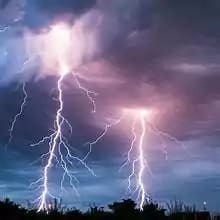The Best Thing You Can Do To Avoid Lightning Danger Is Learn And Practice Good Lightning Safety!
No Place Outside Is Safe Near A Thunderstorm!
The ‘30-30 Rule’ Offers The Best Lightning Safety Guidance For The General Public: When you see lightning, count the time until you hear thunder. If that is 30 seconds or less, the thunderstorm is close enough to be dangerous – seek shelter. (If you can’t see the lightning, just hearing the thunder is a good back-up rule.) Wait 30 minutes or more after the lightning flash before leaving shelter.
A House, Or Other Fully Enclosed Substantially Constructed Building, Offers Your Best Protection Against Lightning(“Substantially constructed” means it has wiring and plumbing.) But stay away from telephones, electrical appliances, and plumbing. Don’t watch lightning from windows or doorways. Inner rooms are generally safer.
A Car With A Metal Roof And Sides Is Your Second Best Protection Against Lightning. As in a house, don’t touch any conducting paths leading outside. It is the metal shell that protects you, not the rubber tires.
Lightning Facts:
- Lightning is the #2 weather killer in the U.S., killing more than hurricanes and tornadoes combined. (Only floods kill more.)
- Lightning is the #1 weather killer in Florida, causing more deaths than all other weather sources combined.
- Florida leads the U.S. in lightning deaths, injuries, and casualties.
- Lightning inflicts severe life-long debilitating injuries on many more than it kills.
- Lightning kills about 100 people in the U.S. each year.
- Lightning injures about 1,000 people in the U.S. each year.
Long-Term Effects on Survivors: Primarily neurological and difficult to diagnose. Common symptoms include memory deficit, sleep disturbance, chronic pain, dizziness, difficulty processing information, distraction, and personality changes. Symptoms may not appear until months after the strike.
Support Group: Lightning Strike and Electric Shock Survivors, International – www.lightning-strike.org
Economic Impact: Lightning causes about $5 billion in economic losses in the U.S. each year.


